How to keep your hens laying eggs all winter long: my top 5 tips!
This post was updated (just for you) in November of 2016. Enjoy!
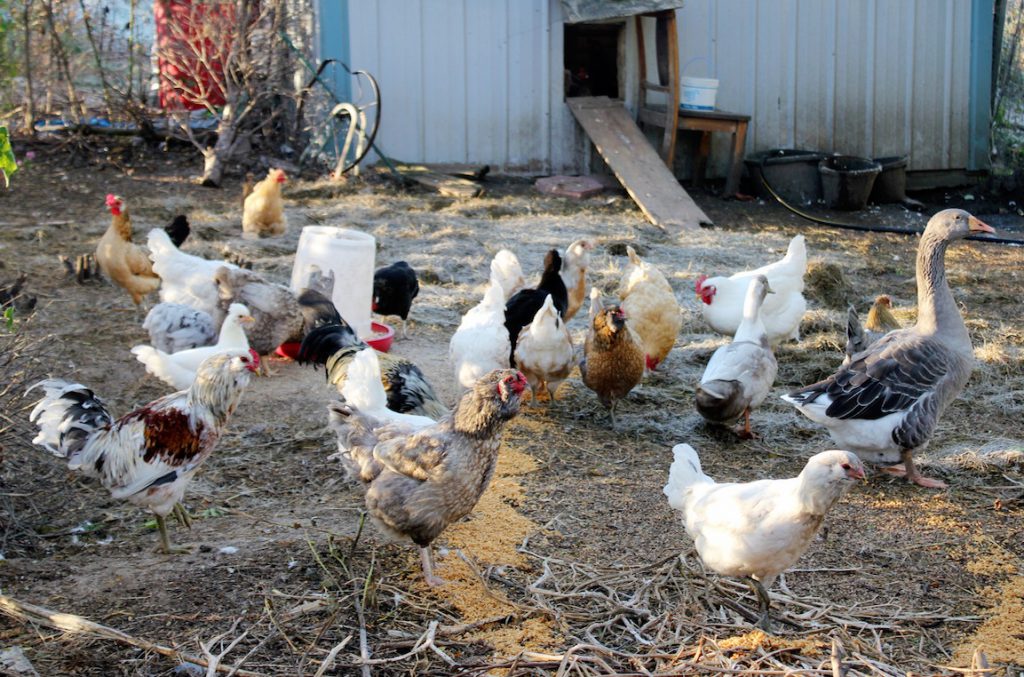
My chooks don’t mind the changing of the seasons one whit. They are spoiled rotten, and continue to lay eggs during all but the coldest days of winter.
My hens are troupers. They are contented egg-laying machines, even through the coldest months. Though the temperatures have been very cold here in Nebraska for the past couple of months (down to 0° and below, some nights, and daytime highs in the single digits, many days) my contented hens continue to lay eggs day after day.
This is no happy accident! I’ve learned a thing or two in the dozen years that I’ve been keeping chickens. For the first couple of years, I didn’t understand how to keep my hens laying eggs all winter, and so their egg production would drop way down during the coldest months. But a little bit of information, and a lot of experience, as they say (don’t they say this?) is a very dangerous thing, and now I’ve got piles of eggs all over the place.
Piles. Stacks. Oodles of eggs! Seriously. So many eggs. Please don’t get tired of eating eggs, kids. Fried egg sammage, anybody?
How about some more frittata . . . anybody?
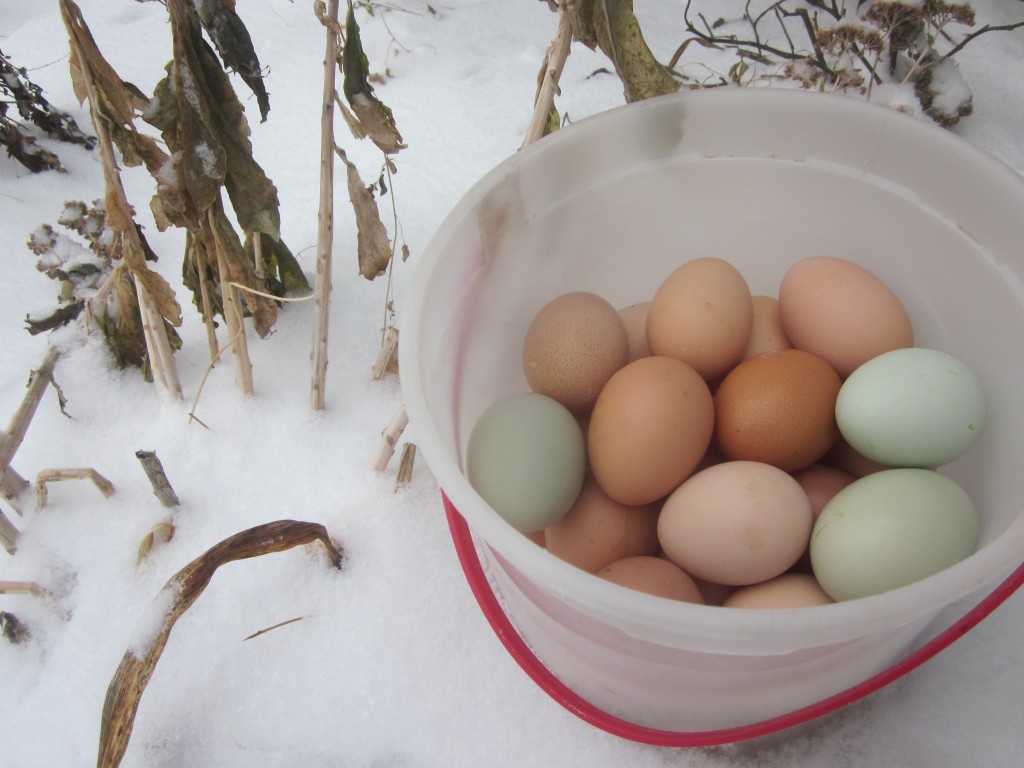
So, without further ado, here are my top five tips for keeping your hens laying all winter long. Follow these tips and it won’t be long before you’re having to find new egg recipes, too. (It’s a nice problem to have!)
More quiche, anybody?
1. Choose your breeds wisely, to begin with. Some chickens are heavier and have looser feathers and smaller combs, making them better at adapting to cold temperatures. From my experience, the following breeds do great for winter laying:
- Buff Orpington: a very calm, friendly chicken, so a good candidate if you have small children or enjoy a relationship with your fowl (and who doesn’t??).
- Rhode Island Red is a chicken that has roots in the U.S., is exceptionally cold-hardy, and is a one of the best layers there is. There’s good reason that this breed is ubiquitous in the feed stores in our area every springtime.
- Silver-laced Wyandotte is a thickly-feathered American favorite very well suited to the cold, with its bigger body and tiny rose comb. Plus, it’s a gorgeous chicken and will just thrill you to pieces if you have a rooster. These roosters are gorgeous, with their black and white lacey-looking feathers! (I have three, if anybody wants one . . . )
- Sussex: Sussex chickens are believed to have been first bred in Britain (in the area that was to become England) around the time of the Roman invasion of AD 43, making them one of the oldest known breeds. You might say they are “vintage,” making them trendy! And you might be right. They are heavy-bodied birds with small combs, making them good for cold weather areas, and they come in many colors. I’ve had good luck with the Speckled Sussex, and I enjoy those speckles on the feathers. They are also a very friendly bird.
- Araucanas: I’ve found that these colorful birds aren’t quite as prolific in their egg-laying as some of the ones mentioned above, but I always add several to my flock, because I love the blue and green eggs! Also, my eye enjoys the varied colors that these chickens come in: white, gray, blue, brown, and combinations! They’re just beautiful.
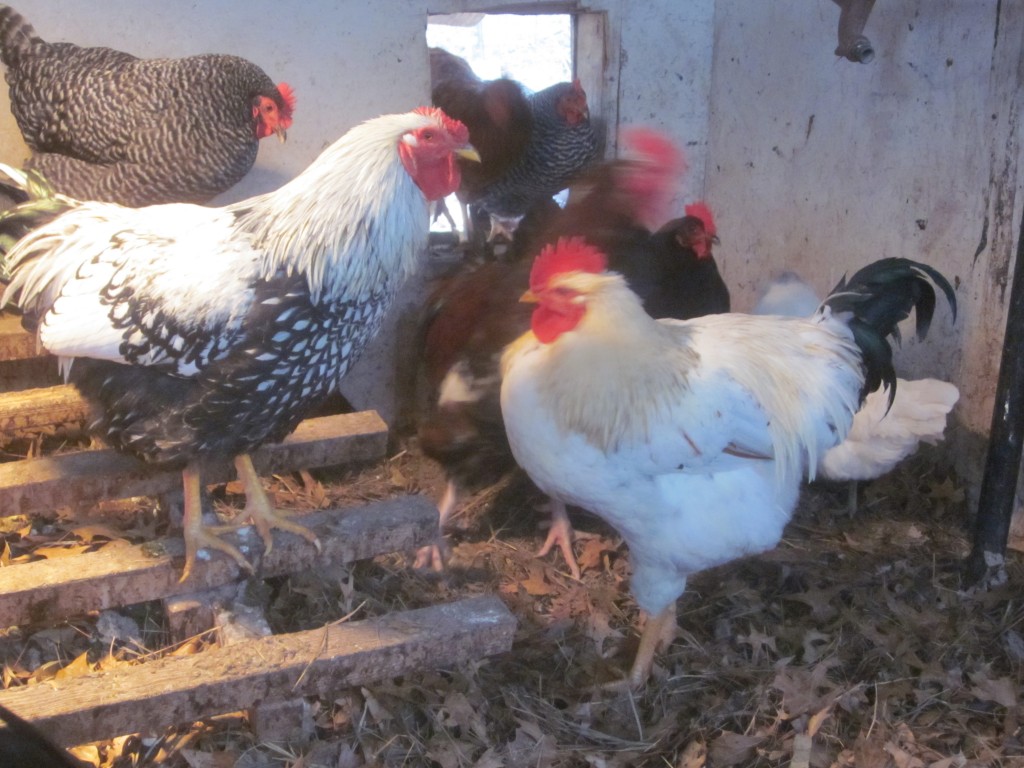
The rooster on the left is a Silver-Laced Wyandotte, and is rather vain, if you want to know my opinion in the matter. His small comb will do better on cold days than that of the big white rooster next to him, who has the bigger comb, which will likely get nipped by the cold.
- Plymouth Rock, once known as the All-American chicken, comes in many varieties and is also a great winter layer. We have Barred Plymouth Rocks right now (see a hen on the perch in the photo above) and I have found them to be the nicest chickens. As a matter of fact, I have two of them that are broody right now, poor things–if they are broody again next summer, I’ll let them try their hands (so to speak) at being mamas.
2. Let there be (Additional) Light. This is a bit of a controversial issue, among chicken owners and especially sustainable-farming-type folks. I think their argument is this: since chickens in their “natural habitat” go into a molt and take the winter (or when the days get short) off from laying, that’s what is believed to be best for chickens today. I can see the reasoning in this, especially if you plan on keeping your chickens through their natural life, i.e., until they die naturally, whether they are laying or not. Of course this could be 5 or 8 or 10 years.
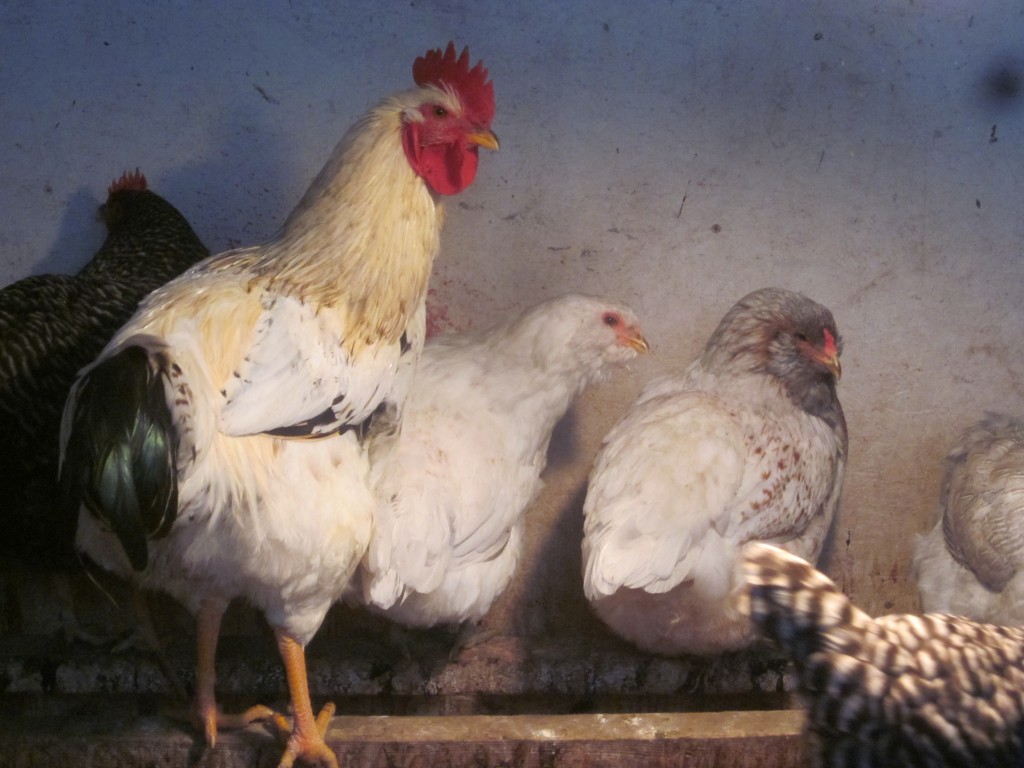
On the coldest days, I leave the light bulb–or a heat bulb–burning all day long and it provides great comfort for my chickens.
8 or 10 years of feeding chickens that are not producing a thing . . . hey, that’s okay if you have chickens as pets. We do have a number of chickens that are pets (around here, once they are named, they have automatic tenure until they die . . ) and I don’t mind that, but the great number of our flock are producers. They produce eggs until they don’t any longer, and then (after a suitable grace period) we butcher them and they produce tasty bone broths and soups. It’s the circle of life around here, at least for the chickens.
So I part ways with this “all-natural” philosophy, and I’m not ashamed to say it. (Dodging eggs thrown at me.)
Did you know that hens are born with as many eggs as they will lay in their lifetimes? So if you plan to keep your chickens (as pets, say) until they die a natural death, it may not make sense for you to use light to keep your chickens laying through the winter.
If, however, egg production is important to you, as it is to me, you may want to use light to encourage your chickens to lay through the winter months. For my flock, it makes sense because I rarely keep a chicken (except for Babes and Little Red and Nellie and Butterscotch and Cruella and RedBeak . . . ) beyond her third or fourth birthday, because at that point she may be laying one egg a week, if that, and for me the feed costs are just too high to justify too many feathered pets in the barnyard. A few are okay. . . 😉
In any case, my hens do take breaks from laying during the absolutely hottest weeks (don’t blame them) and also the very coldest weeks (ditto) so I don’t feel guilty about keeping them laying through the winter. An idle chicken is an unhappy chicken, don’t you agree, and encouraging my hens to lay their eggs is easier than teaching them to knit, wouldn’t you agree?
Care for an egg, honey? Scrambled, fried, or poached?
My supplemental lighting method is very simple: I suspend a light bulb, in a light fixture with a wire guard on it, above their perches. I set a timer so the light comes on and wakes the chickens up very early, so they’ll have about a 14-hour day. For example: right now it gets dark outside around 6:00 p.m., so I know they’ll be asleep on their perches by then. So the timer turns on the light at 4:00 a.m., so they’ll be up and moving about that early. Sorry, chooks, I know it’s early! I don’t let them out of the coop until I’m active, say between 7:30 and 8:00ish.
One more tip: I do check that light bulb very often, to make sure it’s still working. If you don’t check it and it burns out, you may not know about it until your chickens go into a molt and then your egg production will go way down, very quickly. So check the bulb!
IMPORTANT SAFETY ISSUE: I do not recommend using a heat bulb in the coop, which is filled–as it is at our place–with dry leaves, straw, woodchips, and chickens, which are all quite flammable. Roosters will thrash about and it’s possible that the light fixture will be knocked down onto the bedding. That’s why I only use a light fixture like the one below, with a secure guard, and a light bulb–not a heat bulb.
This works very well for us, and I’ve never noticed that my hens are stressed or unhealthy, from this gentle nudge to keep them laying through the winter.
3. Fresh water and plenty of grain: Though I keep their feeders outside the coop, in their yard, I keep fresh water in the coop. Also, I sprinkle grain on the bedding when I shut the chickens into their coop at night. I do this so the chickens can start their eating and drinking and moving about as early as possible, also so they’ll not give in to boredom and start picking at each other and/or fighting. Chickens can be a cantankerous lot, especially if they are shut inside for long, so I provide other things that they can do, until I let them out for the day.
That brings me to . . .
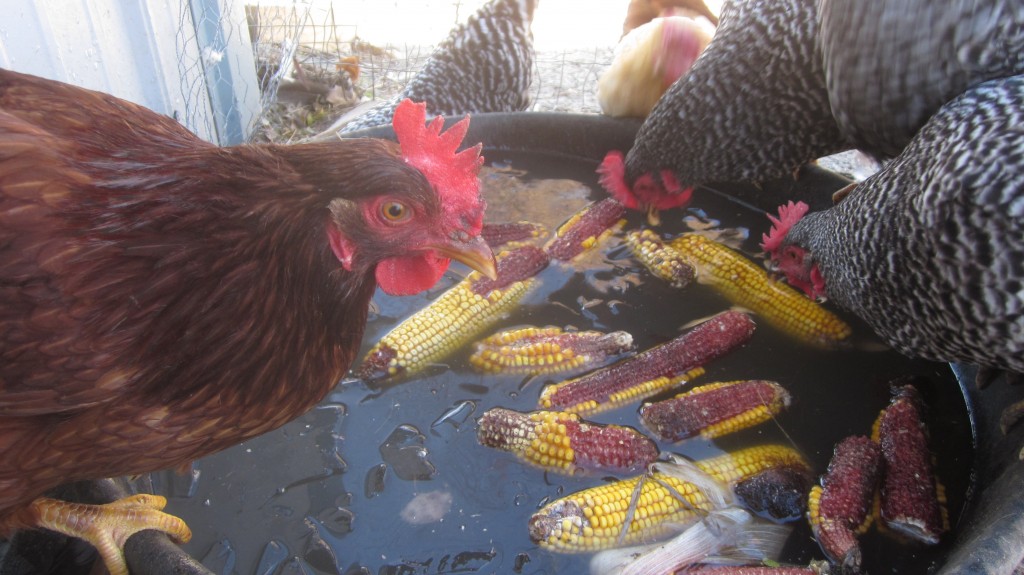
My chooks love it when I throw cobs with corn on them into their water bucket.
4. Deep litter . . . You wouldn’t believe the piles of hay and straw and dry leaves that I pile into the coop through the fall! By winter, it’s several feet deep, and it’s cozy as all get-out in there! There are lots of great reasons for using the “deep litter” method, chief among them (to me) is that it makes for a more comfortable coop situation. Since I sprinkle grain in the coop every night, there are always little bits of food in there, so the chickens stay busy, turning the bedding and fluffing it up. Once a week I help them, turning the bedding with the pitchfork, and I add fresh bedding every month or two, too.
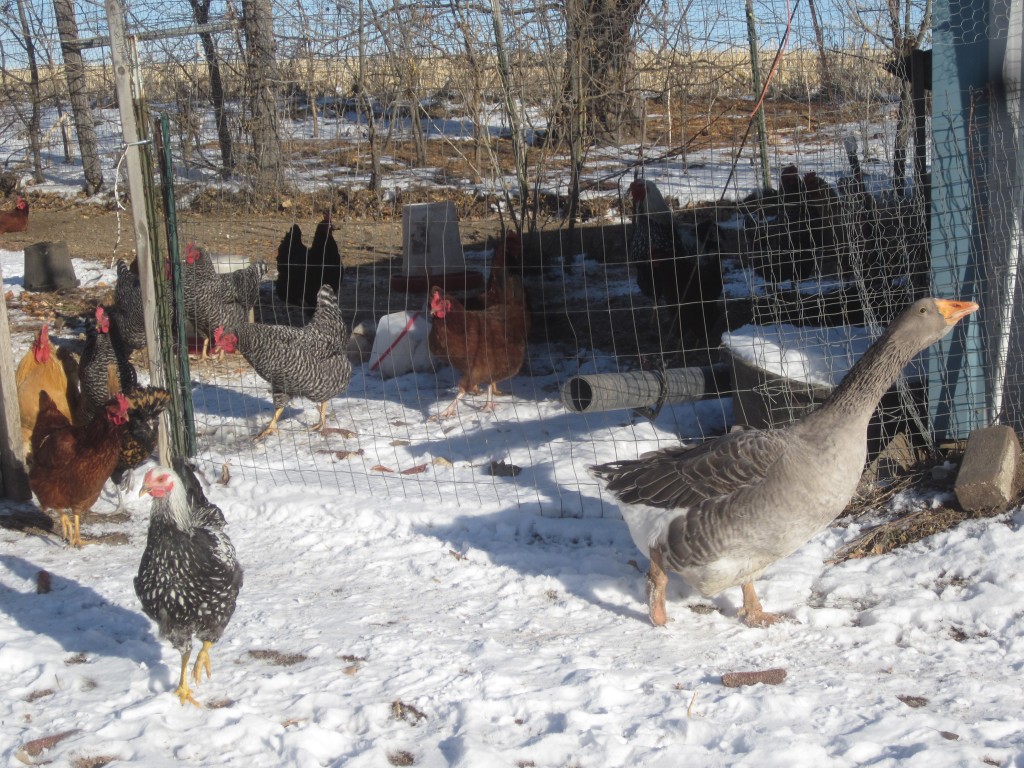
Even in the snow, my chooks (and my goose, Lucy) find little bits to snack on.
I’ve got to admit, I enjoy wielding that pitchfork! Honestly, I guess it’s one of those farm-woman-geeky things, but I like my pitchfork. 🙂
5. Outdoor feeding. Okay, I know that this is purely anecdotal, but the fact is, I believe my kiddos are healthier if they spend some time outside every day, even during the winter. I push and shove and encourage some outside activities most days of the year. So if my kiddos stay healthier by moving around outside in the sunshine, I think my chickens ought to, too. So I keep the feeders outside in the chicken yard, a good distance from the coop. The hens are forced to move about in order to feed themselves. Now when there’s a blizzard or a real cold stretch, I move the feeders inside. I do have a heart. 🙂
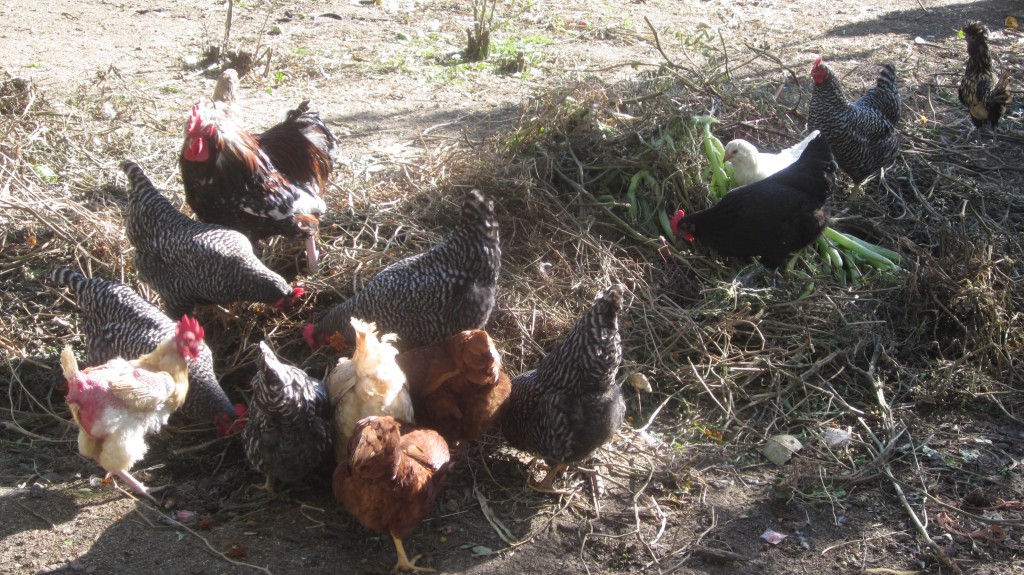
The chickens are working on that compost pile in their yard. What fun! What discoveries!
I open the yard gate in mid-afternoon, just like I do during the summertime, for free-ranging. Even though the world is frozen, the hens will take dust baths in my garden dirt, and find little bits of grass and weeds to snack on.
Also, I pile large amounts of brush and leaves and hay bales (the Christmas tree is going out there this week, too) in the chickens’ yard, so they’ve got plenty of places to peck and scratch and explore. I want to avoid the cold, hard, poop-covered bare yard. The chickens basically have their own compost pile going on in their yard, and underneath it all there are plenty of itty bugs that they can eat, now isn’t that cool?
So, that’s it! 5 super-easy tips on how to keep your hens laying eggs all winter long! It is certainly worth a bit of time and trouble for me to have a steady supply of eggs, even during the winter months.
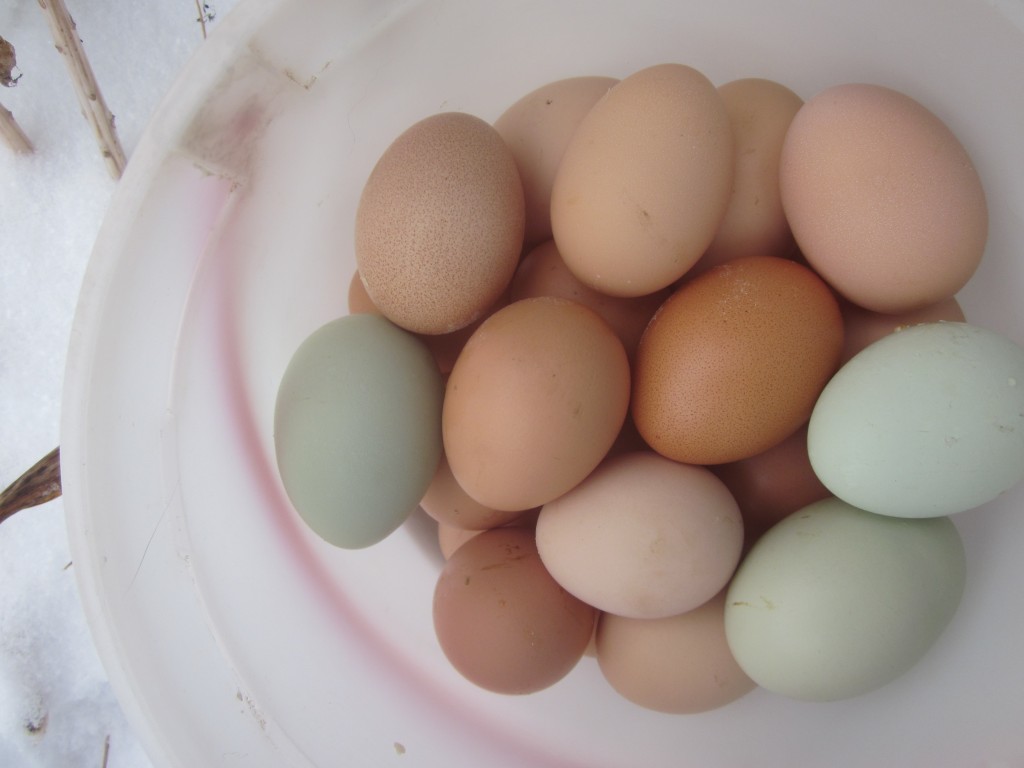
So what’ll it be today . . . scrambled or fried?
I’d love to hear about your strategies for keeping your hens laying through the winter . . . or even why you may not choose to do such a thing. The comment line is open, gentle readers. I’d love to hear from you.
AND. . . hey! I just released a brand spankin’ new ebook, filled with over a hundred new chicken raising tips and tricks, learned by yours truly through over a decade and a half of raising chickens. Snatch yours up today!
Oh, hey, You! and if you want to keep up with me and my chickens and all the shenanigans around here, please be sure to check in on my social media. I post photos and videos on Instagram and Facebook that you won’t (I promise!) see anywhere else.
See ya there—!
*hugs*



Comments working yet? Jeepers, I’m sorry!
Hi there! This is our first year raising chickens and I stumbled onto your blog while trying to figure out what we need to do to get our egg production back to an acceptable level. Suddenly our roost is full of a buncha’ free loaders!! Thanks so much for the tips, I love your writing style and will be following your blog moving forward. Thanks so much!
Welcome, Rebecca! Thanks for chiming in. Good luck with your free-loaders and let me know if I can help you with anything!
Can you recommend where to get a light with a timer? That was a wonderful idea, and we won’t have to get up at 4:00 a.m.! Thanks! This article sold me on your blogs!
Lori, I think you can find a cheap timer (I think the ones I use are around $5.00) at any farm store or big box store. I bought mine at Wal-Mart, I think. I plug in the brooder light to the timer. Easy peasy!!
Hey Amy! I can comment now! 🙂
You have so many eggs! How many hens do you have in total?
Sophie, thank you, thank you, for trying again, I really appreciate it!! <3 So good of you. To answer your question: I'm not sure!! I think I have about 20 pullets who are just starting to lay, and about a dozen older hens, and then another dozen "pets" (named ones that will always be here) and then several roosters thrown in there, too. Too many, Sophie! I get about two dozen eggs every day right now, and my daughter sells what we can't eat, and we give away some, too.It's a nice problem, having too many eggs, I've got to say!
My chicken envy is now at an all time high….. What a fabulous blog, I have learnt so much 🙂
Thank you Anita-Clare!
Good to know the problem of not being able to comment wasn’t up to me. I couldn’t have fixed it anyway.
As to the post, I love the thought of keeping the hens happy all winter. I guess they’re like human women–born with their quota of reproductions.
Francene,
If my chickens are uncomfortable, I’m uncomfortable, so I’m selfish enough to want them to be comfy!
In my 4 years of keeping chickens, we did all of the 5 things you suggested – didn’t do Christmas trees/brush but did just about everything else. We had great success with winter laying and used most of the breeds you suggested. Could I also suggest Black Australorps, noting our experience was in Northwest Arkansas. We did get down to about 15 below zero there but the winters were a lot shorter than they were in Nebraska. The supplemental lighting, we found, was a must. Now you got my husband to wanting to have chickens again, which aren’t allowed in the zoning where we live. But we could have four chickens if we moved to Binghamton….
Alana,
Yes! Black Astralorps, that is one that I forgot. In fact I have a couple of them and I am fond of them because their eggs are a darker brown than the others. What city do you live in now? Maybe you need to go to the city council and get the law changed so you can have a few chickens where you live. Your neighbors would thank you, the first time you shared surplus eggs with them! 🙂
Great to read how much work my grandmother and grandfather did as a “retirement” project. They sold eggs and chickens and I am told that they got 100 plus new chicks per month, I do remember helping grandpa feed the chickens when we got to visit them. It was great fun for me to help him. Always plenty of eggs which might have something to do with how much I enjoy them today.
I love eggs, too, Chef, and am always looking for new ways to fix them. If I’m not careful, though, my family cries fowl . . er, . . . foul. . . they miss “real meat” if I do too many egg meals in a week!
I am looking into heavier breeds this time. It is good to know that they do winters better.
Thanks
Great post however, I have done and continue to do all the things you are talking about and still my 50 hens are giving me 4 to 10 eggs a day. The first few years that I had hens, they layed through the winter but last year, and then again this year, they have slacked off. All the hens are young, all are the same breed I have had for the past 5 years but still…no eggs! My breed of choice is the red sexlink which has the rhode island red heritage. My feeders are indoors but my waterer is outside. We live in Montana and last winters was very cold, negative teens and twenties for a lot of December and January. This winter we have had that cold spell as well but even when the weather warms to above zero they are not laying a respectable amount of eggs. Also, I feed some commercial feed but the majority of their feed is sprouted barley. Could that make a difference.? They have feed in front of them all the time so they are not hungry. That is the only thing I have done different these past two winters.
Dareen, I know it must get VERY cold there in MT. Will they actually go out when it’s super cold and drink? If I were you, I’d start giving them some commercial feed, and move a waterer INSIDE. They probably spend half their day (at least) inside, by the time they hunker down for the night in the early evening, and you then go outside to let them out (morning)–that’s a long time to be without a drink of water. I probably would do those two things before I gave up on them. Plus (another thought) if they are eating inside, but not drinking, they could get impacted crop. Good luck!
Just wanted to suggest to Dareen that chickens need calcium to make the egg, not sure how much calcium is in barley. Might want to have some crushed oyster shells for them to peck at. And I have heard that roosters make them want to lay eggs – can’t understand why. Of course I only have guinea hens here in Maine, so now I am used to no eggs until May or June and then its over in September.
THomas, well, then, friend, it sounds like you need a few chickens!
I really found your postings and comments from others very helpful. I have only 5 hens here in ontario canada but I have built them a very sturdy coop. They are a feisty bunch that have not begun to lay, but I am hopeful it will be soon. I am concerned about the winter as we hit -40 in our peak winter season. I found your blog had the answers I was looking for. This is a new and small hobby for me and I love it. Thankyou, Karen.
Karen, do be sure to sign up to my email list so you don’t miss a post. Good luck with your hens! My little flock is a daily source of joy for me (and fresh eggs, of course!).
This a very good blog!I am glad my husband found it.I was concerned about my hens for the winter,so I got a playhouse and a 5×5 dogpen to move them closer to the house so they could have electric.Then I wanted to give the playhouse to granddaughters,know after reading this .It is going to my chicks.Thanks so much ,will do it all.I love them sooo
I’m sure your love for your granddaughters knows no bounds, too, Grandma Barbi! 😉
My chickens will be up soon and here I am reading blogs about my little pals…I was trying to figure out whether my silkies in the hen house were going to be cold tonight on Bainbridge Island. i have a red heat lamp in the henhouse, and I use a deep litter method, and I supply both food and water available everywhere.However, tonight it will be 31 degrees and I turned the light off at 10:00 p.m…they have many pals and roosters for snuggling purposes, but will they be cold? They were born to a broody Aracauna Momma on July 12 this year, so are still young.
I have two separate henhouses because my roosters started acting up…but the larger henhouse is very cosy, and it is a peaceful kingdom. Both homes were custom made by my brother and have numerous windows, coverings, inserts,roosts,etc…plus, every single day I make “chicken spaghetti” for my chickens, morning and night…spaghetti,corn,meat,grapes…they are spoiled.(they eat organic crumbles,chicken scratch, cracked corn, oatmeal daily too.Plus a daily addition of organic lettuce discarded as compost at our local market)
Anyhow, I am not worried about the French Marans,Orpingtons,Rhode Isl. reds,Aracaunas,Sicillian Buttercups,or Barred Rocks…just the gentle little silkies.
Wow, Liz, it sounds like you are doing everything right. And no worries, as long as your chooks can get in that coop out of the wind, they should be okay. Chickens aren’t really that bothered by the cold as we might think, as long as they can get out of the weather and don’t get wet. Here’s another tip for you, just in case you haven’t thought about it: Another thing I do when it’s very cold, is to sprinkle cracked corn or scratch grain on the deep litter in the coop, when I shut the chooks in at night. When they wake up in the morning, there is always a bit of time before I go out to let them out for the day, and they spend it pecking and scratching up that grain, which is going to help them warm up a bit, too. I like your idea of “chicken spaghetti”! You sound as nuts about your chickens as I am about mine! 😉 (And that’s a compliment.) *hugs* By the way—-Bainbridge Island! What a lovely place to live!
Hi from Thiruvananthapuram, the Southern tip of India. I am 61 and just started keeping chicken in the backyard for my granddaughter , who is 18 months and hates store bought egg smell.
We do not have winter and had unusually hot weather. But it rained a couple of days back and it was a dull, dreary day of continuous drizzle. Our four pullets have been laying randomly for about a month. No egg on the rainy day.
I intend to post pictures of our small chicken coop in my blog soon.
Thank you.
I have oegb would this work for them as well
I don’t have much experience with OEGBs, Bud, but I can’t think of why it wouldn’t work with them, too.
I’ve heard of people putting live crickets from the pet store into the coop in winter to give the hens some fun and exercise. That would certainly do the trick. 🙂
Ha! That’s awesome Jacob. If they ever have a really good sale on crickets (CRICKET SALE! BLACK FRIDAY!) at our local pet shop, I’ll try it. I’d have to stay in the coop and watch the fun, though. My chooks would be all over them.
Thanks for your information about the egg laying during the winter time I did like you did also. I let them out eating grass out in the backyard of my house when i want them to come in the coop i bring out treats every time one of them hop on my leg while i’m sitting on my lawn chair, eating treats off my hands..It’s good theing that i have one lot garden with fence around. I let them out to search for bugs.
Well done, David!
Hi, I was wondering when you clean out your coop
Hi Brenda. I clean out my coop twice, usually, or whenever it really needs it, and also scoop out any wet spots (like when a bucket of drinking water gets dumped) as they occur. Ideally, I clean out the coop in the spring, when it’s cool and pile the bedding someplace to rot for fall application to my garden and hoop house. And the same with the fall–I clean it out then, too, again piling the manure/bedding someplace to age for spring application. THe chickens, you see, are an unwitting and important part of my organic gardening regimen.
Thank you for the information. We have only been doing chickens for three years and we learn something new everyday. Most people here (North Pole, Alaska) don’t keep their chickens through the winter months due to the cost to keep them warm and healthy. Last winter we had some extremely cold days that caused some me of our hens and our rooster to get frostbite on their combs. We also learned our birds needed a large covered yard so they can get out in the winter. Now I know how to check on the productivity of my hens.
Tee,
I’d love to hear more about what it’s like to keep chickens in Alaska! I’m sure you have some real challenges there.
I would be happy to answer any questions you want to ask.
Okay, Tammy! Here are just a few: 1. Are you living in the part of the state where there are months that are completely dark? And months that are light? How do your chooks deal with that? 2. What are your winters like, and do you do anything special to keep your chooks comfortable during the winters? 3. Do you ever go fishing for halibut and salmon? Sorry, that has nothing to do with your chickens, but my folks went to Alaska and brought home the BEST-tasting fish that they caught!
Hi Amy! Thank you so much for your tips! I am going to try all of these! We live in Godley, TX and we have 28 chickens in our backyard. We also have milk cows and horses and of course our Great Pyrenees! It’s a very large backyard and they used to have free run of the whole thing, but we got really tired of the poop all over the porch everyday and they would not leave our Pyrenees food alone! So we recently fenced off a smaller portion of the backyard. They still have plenty of room to roam but now we don’t have to worry about the dog food or poop. We were still getting between 15-22 eggs everyday before we moved them and now it has gone down to 2-4 eggs a day! Do you think they could be stressed because of the change or is that just a normal sudden drop?? Any help is greatly appreciated!! 🙂 Thank you so much Amy! Have a wonderful day!
Joni,
Chooks certainly will go through egg-laying changes when they are moved like that, but that is quite drastic! Do you have lights set up, to wake them early in the morning? Hopefully they aren’t all going through molt at once? Have you noticed a great amount of feather loss? It sounds more like a molt than stress to me. Get lights hooked up with an automatic timer so they will turn on very early (mine turn on at 4:00 right now, because the chooks go to bed around 6:00 p.m., when the sun sets) and wake the hens up. Sprinkle cracked corn or something in their coop at night so they have a reason to get up and move around (breakfast!). Good luck!
Just heads up about warming lamps….I had a beautiful coop made off the ground and in the winter hung a heating lamp….came home one day to the coop on fire…btw first responders only do houses not chicken coops….they did come watch it burn though….after many questions to many people it seems that if the chickens kick up water onto the lamp it can explode…..and therefore catch a wooden coop on fire…..very expensive and very sad….will led lights work for winter egg laying?
Oh Kat, I’m so so sorry to hear about this. I don’t usually use a warming lamp, but instead a light bulb inside a guard. I’m going to add your note to my blog post, and many thanks for the word-to-the-wise. Again, so sorry for your loss!! I would try the LED lights. The trick is to get the chickens up and moving earlier than they naturally would, with dark winter mornings.